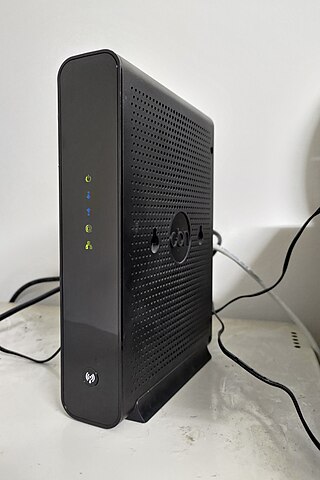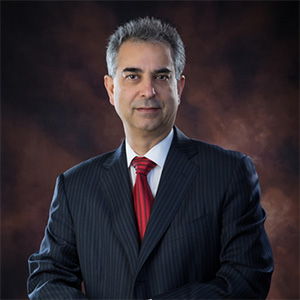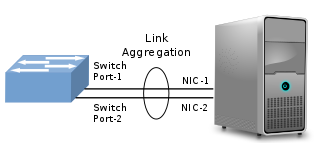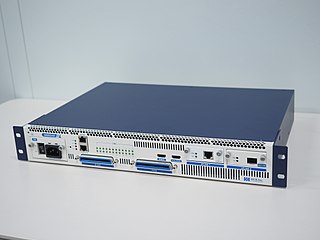Digital subscriber line is a family of technologies that are used to transmit digital data over telephone lines. In telecommunications marketing, the term DSL is widely understood to mean asymmetric digital subscriber line (ADSL), the most commonly installed DSL technology, for Internet access.

A cable modem is a type of network bridge that provides bi-directional data communication via radio frequency channels on a hybrid fibre-coaxial (HFC), radio frequency over glass (RFoG) and coaxial cable infrastructure. Cable modems are primarily used to deliver broadband Internet access in the form of cable Internet, taking advantage of the high bandwidth of a HFC and RFoG network. They are commonly deployed in the Americas, Asia, Australia, and Europe.

Multichannel multipoint distribution service (MMDS), formerly known as broadband radio service (BRS) and also known as wireless cable, is a wireless telecommunications technology, used for general-purpose broadband networking or, more commonly, as an alternative method of cable television programming reception.
Data Over Cable Service Interface Specification (DOCSIS) is an international telecommunications standard that permits the addition of high-bandwidth data transfer to an existing cable television (CATV) system. It is used by many cable television operators to provide cable Internet access over their existing hybrid fiber-coaxial (HFC) infrastructure.

Internet access is a facility or service that provides connectivity for a computer, a computer network, or other network device to the Internet, and for individuals or organizations to access or use applications such as email and the World Wide Web. Internet access is offered for sale by an international hierarchy of Internet service providers (ISPs) using various networking technologies. At the retail level, many organizations, including municipal entities, also provide cost-free access to the general public.

Rouzbeh Yassini, known as the "Father of the Cable Modem", is an Iranian-American inventor, engineer, and author, who has gained international reputation as a "broadband visionary" for his pioneering work in broadband industry and inventing the cable modem, establishing the cable modem industry standards (DOCSIS) through Cable Television Laboratories (CableLabs), the Society of Cable Telecommunications Engineers (SCTE) and the International Telecommunication Union (ITU). He is executive director of the University Of New Hampshire Broadband Center Of Excellence and Founder and board member of the YAS Foundation. Yassini is the author of “Planet Broadband”, a humanized look at broadband technology and its contributions to the society, as well as “Broadband Intelligent Series”, a series of white papers on digital services. He is a worldwide speaker and is often interviewed and quoted in the press for his vision on the future of broadband. His lifetime vision and dream is that all the people in the world have ubiquitous access to the broadband and be connected all the time. He believes that broadband connectivity is a fundamental right for all the human beings, what he has referred to it frequently as "Broadband Equality". Yassini was founder, CEO, and president of LANcity, the early pioneer in cable modems. He has worked with Cable Television Laboratories, Inc. (CableLabs) a research arm of the cable television industry in charge of the DOCSIS and on CableHome projects as the cable industry's point man on standardizing the cable modem's global footprint. He served as a senior executive consultant to the cable industry's CEOs while being president and CEO of YAS Corporation. He also has worked with Comcast and Cablevision on numerous programs relating to innovation of broadband technologies. From 2004 to 2007, Yassini worked with the CTO's office at Comcast to create the first industry standard IP-Set top Box specification known as the RNG specification. He has been involved in managing and advising companies ranging from $100 million to $50 billion and served as member of the board of directors on BAS, TrueChat, and Entropic from 2001 to 2008, and UPC Technical Advisory Committee. He created and chaired the Vendor and Operator Executive Advisory Forum of the U.S. Cable Center. He was a member of the Liberty Global Inc. (LGI) advisory technology board from 2001 to 2017. Yassini was director of Visteon from January 2015 to December 2020. As CEO and Chairman of Irystec, a Montreal-based firm founded in 2015 specializing in perceptual display processing technology, Yassini was able to successfully have the french auto company Faurecia acquire the company in 2020, despite the Covid pandemic. Working for more than 30 years in the broadband industry and achieving major accomplishments, Yassini received many awards from different organizations. In 2024 and 2019 he was inducted to Cable Hall of Fame and Light Reading Hall of Fame, respectively. He was named multiple times as CED Broadband 50 designate. CED Magazine named him “1998 Man of the Year” for creating and fostering the multibillion-dollar cable modem broadband industry. The National Cable & Telecommunications Association (NCTA) awarded Yassini with a 2004 Vanguard Award, the Cable Industry's highest honor in recognition of his contributions and dedication to the industry. The Cable Television Pioneers also inducted Yassini into the class of 2012 for his tremendous and meaningful contributions to the cable industry. He is a member of the Lane Department Academy as well as West Virginia University Academy of Distinguished Alumni.
Hybrid fiber-coaxial (HFC) is a broadband telecommunications network that combines optical fiber and coaxial cable. It has been commonly employed globally by cable television operators since the early 1990s.

A cable modem termination system is a piece of equipment, typically located in a cable company's headend or hubsite, which is used to provide data services, such as cable Internet or Voice over IP, to cable subscribers. A CMTS provides many of the same functions provided by the DSLAM in a DSL system.
PacketCable network is a technology specification defined by the industry consortium CableLabs for using Internet Protocol (IP) networks to deliver multimedia services, such as IP telephony, conferencing, and interactive gaming on a cable television infrastructure.

In computer networking, link aggregation is the combining of multiple network connections in parallel by any of several methods. Link aggregation increases total throughput beyond what a single connection could sustain, and provides redundancy where all but one of the physical links may fail without losing connectivity. A link aggregation group (LAG) is the combined collection of physical ports.
In telecommunications, cable Internet access, shortened to cable Internet, is a form of broadband internet access which uses the same infrastructure as cable television. Like digital subscriber line and fiber to the premises services, cable Internet access provides network edge connectivity from the Internet service provider to an end user. It is integrated into the cable television infrastructure analogously to DSL which uses the existing telephone network. Cable TV networks and telecommunications networks are the two predominant forms of residential Internet access. Recently, both have seen increased competition from fiber deployments, wireless, mobile networks and satellite internet access.
In telecommunications, an IP Detail Record (IPDR) provides information about Internet Protocol (IP)-based service usage and other activities that can be used by operations support systems (OSSes) and business support systems (BSSes). The content of the IPDR is determined by the service provider, network/service element vendor, or any other community of users with authority for specifying the particulars of IP-based services in a given context. The IPDR specifications were originally produced by the Internet Protocol Detail Record Organization, Inc.. In 2007, the IPDR.org organization was acquired by the TM Forum, an industry association of more than 900 global members in over 160 countries from across the converging industries of telecom, cable, media and the Internet. The IPDR specifications include requirements for IPDR collection, encoding and transport protocols to exchange IPDR records, the IPDR service specification design guidance, and several sample IPDR Service Definition documents. The IPDR specs are maintained and continue to evolve at the TM Forum Interface Program. The President/COO of IPDR was Kelly Anderson and the technical team lead of IPDR from 2004 until it was Amit Kleinmann of Amdocs.
Navini Networks was a company that developed an Internet access system based on WiMAX wireless communication standards. This access system was subsequently acquired by Cisco Systems in October, 2007.

Avram Miller is an American businessman, corporate venture capitalist, scientist and technologist. He served as vice president, Business Development for Intel Corporation (1984-1999). With Leslie L. Vadász, he co-founded Intel Capital. He led Intel's initiative to help create and expand residential broadband Internet access.
Dr. Richard R. “Dick” Green is best known for his work heading up Cable Television Laboratories (CableLabs), the research arm of the cable industry, and for his work with international television standards organizations. After a more than 50-year career in telecommunications and television Green was honored with a Prime Time Emmy for lifetime achievement from the National Academy of Television Arts and Sciences, and was inducted into the Cable Hall of Fame.
Subisu Cablenet Ltd. is a Nepalese Internet Service Provider company located in Kathmandu, Nepal, and was established in 2001. Subisu employs over 1500 full-time employees, of which around 900 are technical and around 700 are non-technical. As of 2023, the company has over 235,000 customers. It has coverage in all 77 districts of Nepal. Subisu primarily provides cable and fiber internet and digital TV services through a hybrid fiber-coaxial (HFCC) network.

G.fast is a digital subscriber line (DSL) protocol standard for local loops shorter than 500 meters, with performance targets between 100 Mbit/s and 1 Gbit/s, depending on loop length. High speeds are only achieved over very short loops. Although G.fast was initially designed for loops shorter than 250 meters, Sckipio in early 2015 demonstrated G.fast delivering speeds over 100 Mbit/s at nearly 500 meters and the EU announced a research project.

Ziggo B.V. is the largest cable operator in the Netherlands, providing digital cable television, Internet, and telephone service to both residential and commercial customers.
Hitron Technologies is a Taiwanese company founded in 1986 as a telecommunication equipment supplier and headquartered in Hsinchu City, Taiwan.
Shlomo Rakib is an Israeli electrical engineer known for his work on Orthogonal Time Frequency and Space (OTFS) and other engineering topics. He is the holder of several patents and co-founder and current Chief Technology Officer of Cohere Technologies, which he had co-founded with Ronny Hadani. He also co-founded Terayon in 1993.








